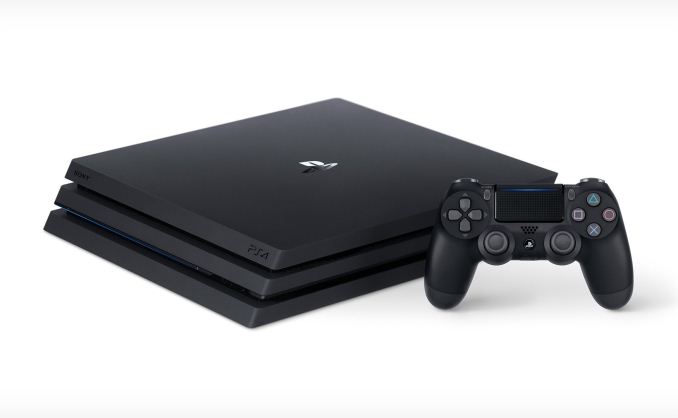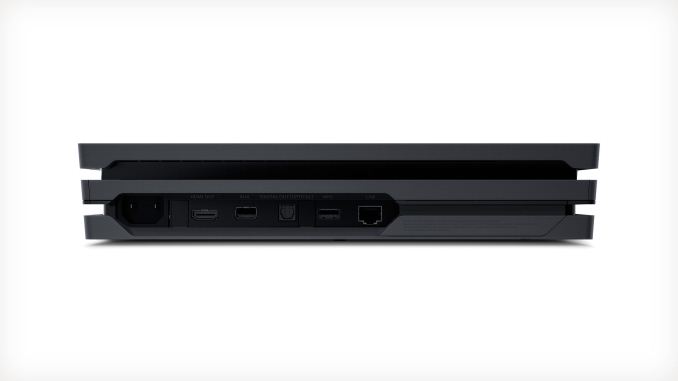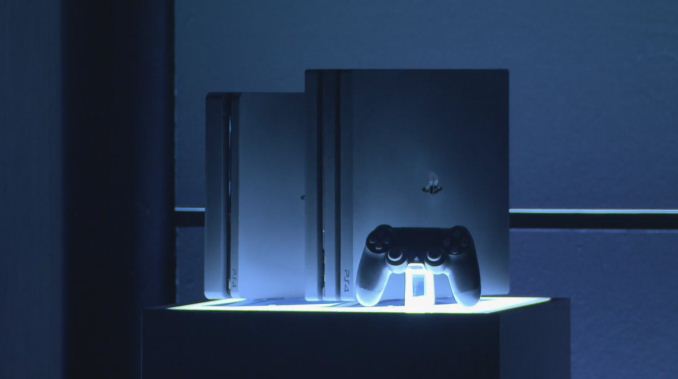Analyzing Sony’s PlayStation 4 Pro Hardware Reveal: What Lies Beneath
by Ryan Smith on September 8, 2016 8:00 AM EST
A few months ago near the start of E3, Sony made an interesting revelation: that they would be releasing a higher performing PlayStation 4 console. A console intended to complement the standard/slim model, this faster PlayStation would be an unusual – if unprecedented – mid-generation update of sorts for Sony’s console family. Previous generations of consoles have offered add-ons, but a significantly faster model is something else entirely.
In any case, after much speculation and a fair bit of analysis on how the PlayStation 4 ecosystem would work with multiple models, in an event in New York City this afternoon, Sony announced the new console. Dubbed the PlayStation 4 Pro, it would sit alongside the newly launched slimmer PS4 (an original PS4 with a die shrunk SoC) as a premium, more powerful entry in the PlayStation 4 family. The console is intended to cover a spectrum of use cases for Sony, including 4K TV support, HDR, better VR performance, and higher fidelity graphics on today’s 1080p TVs.
As AnandTech is not a gaming website, I’m going to skip the gaming ramifications. Instead, let’s do what we do best and dive into the hardware.
PlayStation 4 Pro: AMD’s Next Semi-Custom SoC Win
A bit to my surprise, Sony actually released some basic specifications about the underlying hardware. The information is similar to what we were given close to the PS4 launch, but at the same time I wasn’t expecting this information until we were closer to the PS4 Pro’s November launch.
| Sony PlayStation 4 Spec Comparison | ||||||||||||||
| PlayStation 4 (OG) | PlayStation 4 (Slim) | PlayStation 4 Pro | ||||||||||||
| CPU Cores/Threads | 8/8 | 8/8 | 8/8 | |||||||||||
| CPU Frequency | 1.6GHz | 1.6GHz | > 1.6GHz | |||||||||||
| CPU µArch | AMD Jaguar | AMD Jaguar | AMD Jaguar | |||||||||||
| Shared L2 Cache | 2 x 2MB | 2 x 2MB | 2 x 2MB? | |||||||||||
| GPU Cores | 1152 (18 CUs) | 1152 (18 CUs) | 2304 (36 CUs)? | |||||||||||
| Peak Shader Throughput | 1.84 TFLOPS | 1.84 TFLOPS | 4.20 TFLOPS | |||||||||||
| System Memory | 8GB 5.5 Gbps GDDR5 | 8GB 5.5 Gbps GDDR5 | 8GB ? Gbps GDDR5 | |||||||||||
| System Memory Bus | 256-bits | 256-bits | 256-bits | |||||||||||
| System Memory Bandwidth | 176.0 GB/s | 176.0 GB/s | 176.0 GB/s? | |||||||||||
| Optical Drive | 6x BD | 6x BD | 6x BD | |||||||||||
| Power Consumption (Up To) |
250W? | 165W | 310W | |||||||||||
| HDMI | 1.4 | 1.4 | 2.0 | |||||||||||
| Manufacturing Process | 28nm | 16nm? | 16nm? | |||||||||||
With a focus on increased performance, the heart and soul of the PS4 is a new, higher performance SoC from AMD. One of AMD’s semi-custom design wins for H2’16, Sony has released certain details that help paint a useful, though not quite complete picture of what this SoC can do.
On the CPU side, Sony is not officially discussing clockspeed. However they have confirmed that it is still an 8 core Jaguar design like the original PlayStation, so there are no additional CPU cores in play. Furthermore the CPU clockspeed has been boosted by an undisclosed amount, so total CPU performance has increased.
While I have some ideas on what those numbers may be, it does depend in part on how much work AMD put in on the semi-custom stage of the design process. The newer manufacturing process – which I believe to be TSMC’s 16nm since that is AMD’s regular semi-custom fab partner – certainly delivers some benefits. But at the same time the Jaguar architecture was not originally designed to scale to very high clockspeeds – keep in mind that this was a low power architecture to begin with – so there are frequency bottlenecks besides simple silicon limits. For reference, the fastest desktop Jaguar desktop processor topped out at 2.2GHz. Unless AMD has done any major reworking of Jaguar for Sony, that is about as good of a guess as we can make, short of Sony confirming any numbers.
Meanwhile on the GPU side, things get a lot more interesting. The PS4 Pro’s SoC features a far more powerful integrated GPU, more than doubling the rated performance of the original PS4. Overall the PS4 is rated for 4.2 TFLOPs, versus 1.84 TFLOPs on the original console. In terms of raw throughput, this is to AMD’s current-generation mainstream discrete GPUs, offering throughput somewhere between the RX 470 (4.9 TFLOPs) and the R9 380X (4.0 TFLOPs).
The significant increase in GPU performance is easily the biggest selling point of the new console, and is the cornerstone of Sony’s plans to pitch the console as a higher fidelity alternative to the stock PS4. This includes both higher quality rendering (e.g. more objects, better shadows, etc) and higher framerates, but also higher resolutions as well as part of Sony’s greater push to make the PS4 Pro synonymous with 4K.
As far as the GPU configuration goes then, officially we don’t have anything to work with besides the raw throughput. Clockspeeds and CU counts are both very good questions right now, as the jump to 16nm will have improved both AMD’s ability to pack in more CUs in a given area, and, at least to some extent, rev up the clockspeeds. So how AMD has opted to balance these factors is an interesting question.
Given that GPU throughput has increased by 2.3x, my hunch is that AMD has pushed both aspects. A straight doubling in the CU count coupled with a modest (14%) increase in the GPU clockspeed would reach the stated performance numbers without too radical of an alteration of the GPU architecture. But there’s a lot of wiggle room here; it could just as easily be 34 CUs at a higher clockspeed, for example. A wider design favors power efficiency – which is always a boon in a console – but as 16nm is still a newer process, it’s a chip yield risk.
Meanwhile, it’s important to note here that as we’ve seen in the discrete GPU space, shader throughput is not everything. Shaders are indeed frequently the biggest bottleneck to GPU performance, but they are hardly the only one. One way or another AMD has greatly increased the shader throughput of their SoC, but rather they’ve increased the unit counts on any other aspects remains to be seen. Whether they’ve added additional geometry units or ROPs could significantly influence the performance of the console, as it’s going to be relatively harder to fill up those expanded shader resources if these other resources weren’t similarly expanded. At the same time we don’t know anything about how the GDDR5 memory is clocked; I think it’s a safe bet that it’s clocked higher since the original console was only at 5.5Gbps, but even 7Gbps memory would only be 27% more memory bandwidth to feed a much wider GPU. In short, it’s best not to assume that all aspects of the GPU have been doubled, and consequently that the real world performance advantage for the PS4 Pro is not going to be quite as great as the GPU specs indicate.
On that note, while Sony is pitching the console for 4K video and gaming, Mark Cerny was rather clear that to reach 4K gaming, they expect developers to make significant use of both spatial and temporal anti-aliasing/reprojection.to reach 4K. In other words, most of the time the console won’t actually be rendering games at 4K. This makes a lot of sense; all else held equal, the PS4 Pro needs to fill 4x as many pixels with a GPU that’s (at best) 2.3x as powerful.
This means that the number of games that natively render at 4K is by necessity going to be relatively few. Games could still render at resolutions over 1080p (e.g. 2560x1440), giving them more fidelity than current 1080p games, but various upscaling/reprojection methods will have to close the gap to 4K. Given that even the best PC GPUs have only recently reached the performance level to render the necessary 8.3Mpixels without significant quality compromises, and we’re likely a generation (or more) from consoles being able to reach that same level.












207 Comments
View All Comments
nikon133 - Sunday, September 11, 2016 - link
Sure it can. "Problem" here is, almost any PC can do everything but gaming for most users. My Surface Pro 4 can. My work Acer Travelmate P645s can. My old work EliteBook 8570p (which I was allowed to keep after it reached replacement age) can.I do have a gaming desktop at home, but that's me... and I'm on geeky side. Many individuals cannot settle down for having gaming rig as their only machine, and many also don't want to own multiple computers. Manage multiple updates, software licenses, subscriptions.
Console makes a lot of sense. It is simple, strait-forward. It might end up more expensive on software side, though even that can be avoided with some patience and effort. I've just purchased Doom for PS4 for NZ$36. If I wanted pre-owned, I could have done with NZ$26. Game was over NZ$100 ($109 or $119?) on release, and neither of local gaming shops sell pre-owned PC games. Best PC DOOM price currently is NZ$66. It was a bit cheaper on release than PS4 version, but... for whatever reason, here we are.
nikon133 - Sunday, September 11, 2016 - link
Exactly. And it is not just a cost of good gaming PC build. Some people already have good non-gaming laptop, for example, or AIO - and don't want another PC just for gaming, since laptop/AIO covers all other needs and complements their lifestyle better.nikon133 - Sunday, September 11, 2016 - link
Yeah, but... when you "upgrade" to PS4 Pro, you end up with 2 fully independent, complete machines. You can make your original PS4 into BD player, Netflix box, or simply a guest-room console for some gaming with visiting friends and relatives. PS4 SharePlay kind of plays nicely with this scenario.When you upgrade your GPU, you end up with spare GPU that isn't of much worth, unless you have another PC capable of using it (sufficient space, power and other resources to make it in to gaming machine).
I guess you can sell old GPU. If it wasn't top shelve part (in which case it did cost more than PS4), it will not hold price nicely. 2nd hand PS4 are selling quite solid, at least here in New Zealand.
And... you do get a bit more from this PS4 Pro than just faster GPU. Being complete machine, not just a part, you get CPU boost, faster RAM, new controller. And you still end up with your original PS4 untouched, be it for selling it or re-purposing it. If you'd be upgrading other parts of your PC with GPU, you still end up with handful of old parts not enough to build another machine without further investments.
DarthVulva - Monday, November 14, 2016 - link
Literally locking down your product is not a good idea - the additional costs of shipping all those chains and padlocks would significantly increase the price of the end product.cmdrdredd - Thursday, September 8, 2016 - link
The Pro can render the game at resolutions above 1080p then scale that to 4k with HDR. The original PS4 will get an HDR update next week.gopher1369 - Wednesday, September 14, 2016 - link
VR, the PS4 Pro is for VR content.Wolfpup - Thursday, September 8, 2016 - link
Yeah, but they COULD still end up with versions that look or run dramatically different. Or not.tipoo - Thursday, September 8, 2016 - link
Certification already allows a lot of sub 30fps games to slip through. I don't trust that.RussianSensation - Thursday, September 8, 2016 - link
It would be stupid on Sony's part to force PS5 games to run on PS4 because it would hold back PS5 from realizing its true potential. I know both companies are pushing for iterative consoles (smartphone business model) without console generations but even if that happens, it will mean the generational leaps between consoles will become completely blurred.FourEyedGeek - Saturday, September 10, 2016 - link
Yes / no.What if the PS5 games worked on PS4 Pro but not PS4, the games being compatible one generation either way?
That way, the PS5 games could work on the PS4 Pro, but with reduced graphics and gameplay that utilise the CPU and RAM.